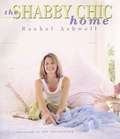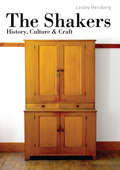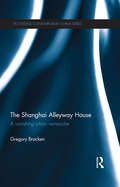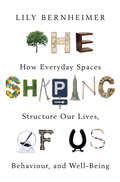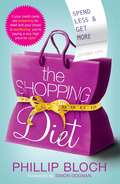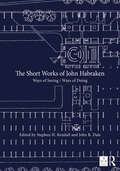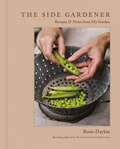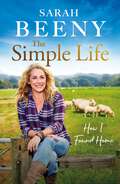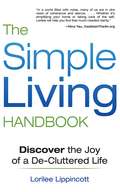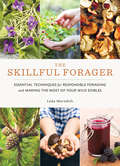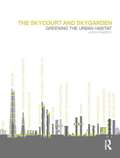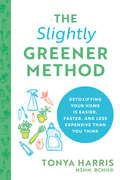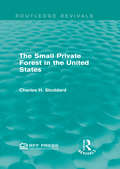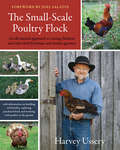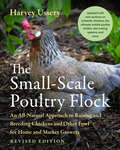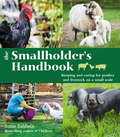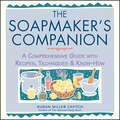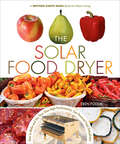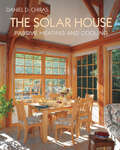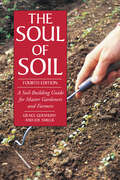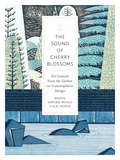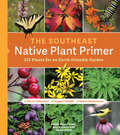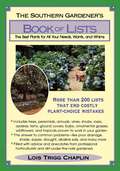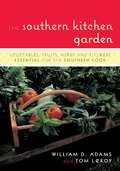- Table View
- List View
The Shabby Chic Home
by Rachel AshwellWonderful wide-plank floors, paned sash windows, an old brick fireplace, the charm of living with a home's small imperfections and making them a virtue. These are just some examples of what makes up a Shabby Chic home. When she first saw what would be her future home, Rachel Ashwell, founder of the Shabby Chic line, was put off by its dark, witchy exterior, gloomy interior, and overgrown garden. But for weeks afterward, she couldn't get the house out of her mind. She went back, took a closer look, and started to see the charm that lay hidden beneath the surface. Excited by the challenge, she bought the house and went to work on it. Inspired by the original design of the 1920s house, Rachel was able to transform it into her bright, cozy dream home, one that had the hallmarks of a Shabby Chic home: a practical amount of space, a relaxed atmosphere, and a comfortable beauty. Through simple instructions and detailed before-and-after photographs, Rachel reveals her decorating and entertaining secrets. Even the most apprehensive novices will learn how to incorporate Shabby Chic style into their everyday life and home. Using her home as an example, Rachel shows you how to assess what needs to be replaced (in her home it was the dark tile in the pool and the bathroom doorknobs), make small structural changes (she exchanged a glass window for a glass door), and keep costs down while adding personal Shabby Chic touches. The gray marble countertop in the guest bathroom and the somewhat noisy glass-front refrigerator were fixtures she would have never chosen, but she left them alone and was pleasantly surprised by the character they added. In her previous books, Rachel showed you how to recognize beauty in overlooked places. Now, in The Shabby Chic Home, she teaches you how to find it in the nooks and crannies of your own home and then apply it to everyday life. She reveals how work, love, a lot of white paint, and Shabby Chic details can turn any new house into a comfortable, functional, beautifully designed home.
The Shakers
by Lesley HerzbergLeaving Manchester, England, in 1774 to avoid religious persecution, the Shakers crossed the Atlantic and during the next 50 years established 19 villages in the United States from Maine to Kentucky. Guided by the principles of utility, honesty, and order, the ultimate goal of the Shakers was to create a heaven on earth in both their worship and their work. Consequently, careful craftsmanship, signature details, an dthe commitment to excellence are seen in every object they produced, ranging from free-standing tables, chairs, desks, boxes, and case clocks to built-in cupboards and cases of drawers. The unique buildings, objects, and lifestyle of the Shakers has set them apart in American art and culture as a matter of course, but ever since "Shaker Handicraft" - the first major Shaker exhibition at the Whitney Museum of American Art in 1935 --the appreciation for Americana and folk art has continued to grow. Today the spirit of Shaker craft, combined with its clean lines, solid construction, and honest functionality, make it one of the most popular and timeless design categories in the US and beyond.From the Trade Paperback edition.
The Shanghai Alleyway House: A Vanishing Urban Vernacular (Routledge Contemporary China Series)
by Gregory BrackenAs a nineteenth-century commercial development, the alleyway house was a hybrid of the traditional Chinese courtyard house and the Western terraced one. Unique to Shanghai, the alleyway house was a space where the blurring of the boundaries of public and private life created a vibrant social community. In recent years however, the city’s rapid redevelopment has meant that the alleyway house is being destroyed, and this book seeks to understand it in terms of the lifestyle it engendered for those who called it home, whilst also looking to the future of the alleyway house. Based on groundwork research, this book examines the Shanghai alleyway house in light of the complex history of the city, especially during the colonial era. It also explores the history of urban form (and governance) in China in order to question how the Eastern and Western traditions combined in Shanghai to produce a unique and dynamic housing typology. Construction techniques and different alleyway house sub-genres are also examined, as is the way of life they engendered, including some of the side-effects of alleyway house life, such as the literature it inspired, both foreign and local, as well as the portrayal of life in the laneways as seen in films set in the city. The book ends by posing the question: what next for the alleyway house? Does it even have a future, and if so, what lies ahead for this rapidly vanishing typology? This interdisciplinary book will be welcomed by students and scholars of Chinese studies, architecture and urban development, as well as history and literature.
The Shaping of Us: How Everyday Spaces Structure our Lives, Behaviour, and Well-Being
by Lily Bernheimer"You are going to be transported by what Bernheimer has to say. You'll make different decisions and figure out how your brain is working and what should be prioritized in your life" Jo Good, BBC LondonWhat makes everyday spaces work, how do they shape us, and what do they say about us?The spaces we live in - whether public areas, housing, offices, hospitals, or cities - mediate community, creativity, and our very identity, making us who we are. Using insights from environmental psychology, design, and architecture, The Shaping of Us reveals the often imperceptible ways in which our surroundings influence our behaviour.Wide-ranging and global examples cover the differences between personalities and nationalities, explore grass-roots and mainstream efforts to build environments promoting well-being, and look ahead to what will become of us if we don't listen closely to what we know is good for us.You will learn whether you are a natural 'prospector' or 'refuger' in the office environment, what roundabouts and stoplights say about British and American culture, whether you are guilty of NIMBYism or being drawn to 'ruin porn', and how the half-house may be a common sight in the near future.The environments we inhabit define our identities - from the earliest moments of our evolution to the worlds we build around ourselves.
The Shopping Diet
by Phillip Bloch"Stop me before I shop again!" When the clothing budget is tight, when you have to squeeze every dollar and stretch it further, it's time to go on The Shopping Diet. But don't worry! This diet won't deprive you of having a fashionable and up-to-date wardrobe--in fact, you will find exciting ways to look fantastic, make more of the clothes and accessories you already have, and come out ahead with the one thing that's always in style: more money in your wallet! Whether you're an impulse shopper, whether you shop out of boredom or other emotions, or if "the tough go shopping" has always been your motto, you may feel that you simply have to shop--that there are never enough clothes, or the right clothes, to make you feel complete, confident, and in control. But in tough economic times, there is a better way--a whole new lifestyle of evaluating your true wardrobe needs, making smart choices, and changing your spending habits from the inside out. The results? More time (no more Saturdays spent wandering the mall aimlessly), more space (your closet makeover will turn that priceless piece of real estate into your favorite go-to boutique!), and more cash (or, if you prefer, less credit card debt). Now that's being in control! Premiere celebrity stylist Phillip Bloch's unique and thought-provoking approach to looking great for less gives you fascinating insights and practical solutions to the very real problem of overspending that affects millions of people.
The Short Works of John Habraken: Ways of Seeing / Ways of Doing (Open Building)
by Stephen H. Kendall John R. DaleThis book offers, for the first time, access to the chronological arc of John Habraken’s writing in a single collection. Few architects or scholars have so consistently and patiently pursued such a humane and culturally vital set of radical questions related to the behaviour of the built environment as N. John Habraken. From the publication of his first book in 1960, he has quietly helped redraw the map of architectural research, education, practice, design methods and theory. His insights lead us to a better understanding of how the built field works, contributing to the development of methods enabling professionals to contribute to its coherence and resilience. Following an introductory essay by the editors, placing Habraken’s work in context, this collection is organized in two sections and further organized around a number of specific themes: The Built Field; Role of the Architect; Control; Sharing Forms; Examples of Ways of Doing; Open Building; Tools; and Cultivating the Built Environment. A series of interviews with the author enable him to reflect on his journey of inquiry, research, advocacy and teaching – and the relationship between ways of seeing and ways of doing. Offering theoretical perspectives and methodological ways forward, this book will be of interest to architects, planners and urban designers tackling the challenges of the contemporary built environment that Habraken identifies, as well as educators and students.
The Side Gardener: Recipes & Notes from My Garden
by Rosie DaykinA cookbook of vegetable-forward recipes celebrating the beauty of freshly grown produce.The Side Gardener is the story of how Rosie Daykin—a bestselling and award-winning cookbook author who also happens to garden a little on the side—turned a languishing patch of land beside her home into an informal working garden.With love and attention, the garden blossomed with a bounty of fresh vegetables and fruit, a near endless supply of beautiful flowers for cutting, and even a few eggs from three very naughty chickens. Rosie shares her notes on how she designed her garden and nurtured it to life, along with the simple recipes she created to let the freshly grown produce shine. Inside, you&’ll find sides and snacks, salads and soups, mains and desserts, all shown through the captivating lens of revered British photographer Andrew Montgomery. Whether the produce you use is from your garden or local market, Rosie&’s elegant recipes will help you celebrate the honest flavors of fruits and vegetables. Filled with witty anecdotes and gorgeous photography, The Side Gardener is all the inspiration you need to create and cook from a garden of your own, no matter the size.
The Simple Life: The unmissable memoir from one of Britain’s most loved presenters
by Sarah BeenyJoin Sarah Beeny on her journey to live more simply and find her forever home...Throughout her life, Sarah Beeny has been obsessed with the idea of home. From her childhood growing up in a countryside cottage to renovating her very first flat in London to restoring a stately home in Yorkshire, she has never been afraid of the hard work needed to turn a house into a home. Now, in her most recent adventure, Sarah and her family have moved to a former dairy farm in Somerset to build the home of their dreams. In The Simple Life, Sarah will tell the story of her life, sharing tales and experiences in everything including parenting, property, friendships, nature and the environment, all the way through to her recent cancer diagnosis and treatment. Through it all, Sarah tackles challenges and troubles with signature wit and wisdom, discovering life is never as 'simple' as you'd like it to be.
The Simple Living Handbook: Discover the Joy of a De-Cluttered Life
by Lorilee LippincottWhere did all this stuff come from? I don’t have time for a life. I need to get away! Ever feel this way? Society is quick to fill our minds and homes with all the latest gadgets, tools, obligations, and entertainment, but what happens when it all doesn’t fit? The Simple Living Handbook is a how-to memoir about creating a life that has space for what really matters to you.Lippincott’s road to simplicity started in the fall of 2010 when she was on the verge of a breakdown. Her life was basically “normal”—husband, two kids, comfortable home, three home businesses—but she felt like she was running a rat race. She was desperate for more time and space to focus on family, health, and her own interests. So she and her husband decided to cut back on clutter—drastically. Now the family of four lives in a one-bedroom apartment with only the possessions they actually need and use; they stick to a simple diet of only whole foods “that God would recognize”; and they have managed to become productive without feeling busy. They’ve never been happier or healthier.Through personal stories, advice, and tips, Lippincott teaches how to make the hard decisions necessary to simplify your home and your schedule. Beyond that, she addresses the hidden emotional hoarding that threatens to keep our souls running in circles. Through her inspiring story, readers will learn to take a step back, reassess priorities, and commit to making space for those people and things that really matter.
The Skillful Forager: Essential Techniques for Responsible Foraging and Making the Most of Your Wild Edibles
by Leda MeredithThe Skillful Forager is the ultimate forager’s guide to working with any wild plant in the field, kitchen, or pantry. From harvesting skills that will allow you to gather from the same plant again and again to highlighting how to get the most out of each and every type of wild edible, trusted expert Leda Meredith explores the most effective ways to harvest, preserve, and prepare all of your foraged foods. Featuring detailed identification information for over forty wild edibles commonly found across North America, the plant profiles in this book focus on sustainable harvesting techniques that can be applied to hundreds of other plants. This indispensable reference also provides simple recipes that can help you make the most of your harvest each season.
The Skycourt and Skygarden: Greening the urban habitat
by Jason PomeroyPopulation increases, advances in technology and the continued trend towards inner-city migration have transformed the traditional city of spaces into the modern city of objects. This has necessitated alternative spatial and technological solutions to replenish those environments that were once so intrinsic to society’s day-to-day interactions and communal activities. This book considers skycourts and skygardens as ‘alternative social spaces’ that form part of a broader multi-level urban infrastructure – seeking to make good the loss of open space within the built environment. Jason Pomeroy begins the discussion with the decline of the public realm, and how the semi-public realm has been incorporated into a spatial hierarchy that supports the primary figurative spaces on the ground or, in their absence, creates them in the sky. He then considers skycourts and skygardens in terms of the social, cultural, economic, environmental, technological and spatial benefits that they provide to the urban habitat. Pomeroy concludes by advocating a new hybrid that can harness the social characteristics of the public domain, but be placed within buildings as an alternative communal space for the 21st century. Using graphics and full colour images throughout, the author explores 40 current and forthcoming skycourt and skygarden projects from around the world, including the Shard (London), Marina Bay Sands (Singapore), the Shanghai Tower (China) and the Lotte Tower (South Korea).
The Slightly Greener Method: Detoxifying Your Home Is Easier, Faster, and Less Expensive than You Think
by Tonya HarrisFrom the foods you consume to the household and personal care products you buy, being just slightly greener can have a big impact on your health and happiness!The Slightly Greener Method gives you small, actionable changes you can easily make in three areas of your home—the kitchen (foods and beverages), bathroom (personal care products and cosmetics), and cleaning products—without breaking the bank or upending your life.You don't have to be 100% chemical free to be healthier and safer. By focusing on micro-habits you can build over time and the gradual introduction of non-toxic, all-natural or organic, eco-friendly products, board-certified holistic nutritionist Tonya Harris guides you along a roadmap to a greener, more environmentally-friendly and sustainable lifestyle that can help protect you and your families' health long-term.Get answers to questions like:What does "organic" really mean?Which of the unpronounceable chemicals listed on the back of my shampoo bottle might be toxic?Do I really need to throw away expired makeup?Why aren't companies always required to list toxic ingredients on their product labels?How can I make sure my kids and pets are safe while also keeping a squeaky clean house?It's never too soon (or too late) to start your slightly greener journey! This practical, actionable guide is perfect for readers of bestselling lifestyle and organizational books such as The Complete Book of Clean and Zero Waste Home, and fans of TV shows like Tidying Up with Marie Kondo and The Home Edit.
The Small Private Forest in the United States (Routledge Revivals)
by Charles H. StoddardThroughout the past few decades, the standard answer to the problem of low productivity in small private forests has been education. It has been assumed that the chief obstacle to "good" forestry has been lack of knowledge. But the stubborn persistence of the problem raises some doubts as to the efficacy of the remedy. In this book, first published in 1961, the author takes a sharper look at this problem. He tries to find out what has worked reasonably well, and what has not, and makes some suggestions as to what seems to offer the best prospects for the future. The Small Private Forest in the United States will be of interest to students of environmental studies, as well as to private landowners.
The Small-Scale Poultry Flock
by Harvey UsseryAn All-Natural Approach to Raising Chickens and Other Fowl for Home and Market Growers
The Small-Scale Poultry Flock, Revised Edition: An All-Natural Approach to Raising and Breeding Chickens and Other Fowl for Home and Market Growers
by Harvey UsseryThe most comprehensive book on how to raise and breed your own poultry flock is now fully updated and expanded&“The ultimate book for those who want to know everything there is to know about raising poultry.&”—Gene Logsdon, author of Letter to a Young Farmer&“There&’s no better introductory reference on the joy of home-raising chickens.&”—Booklist The first edition of The Small-Scale Poultry Flock helped thousands of small-scale farmers and homesteaders successfully adopt a practical and integrative model for working with chickens and other domestic fowl based on natural systems. In this expanded and thoroughly revised edition, readers will find plenty of all-new material. Author Harvey Ussery introduces readers to his new favorite breed of chicken, Icelandics; describes how he manages his breeding flock using a clan mating system; presents detailed information on the use of trapnests and record-keeping spreadsheets for evaluating breeding hen performance; and provides step-by-step instructions for construction of an ingeniously designed mobile poultry shelter.Readers will also find fully updated information and tips on all aspects of flock management, including:Growing (and sourcing) feed on a small scaleCultivating earthworms and grubs as high-protein poultry feedBrooding (and breeding) at homeImplementing manure managementUsing electric net fencing for ranging flocksUsing poultry as insect and weed managers in the garden and orchardEnlisting your chickens as garden tillers and compost-makersProtecting the flock from predatorsKeeping the flock healthyWorking with mother hensUssery presents a sustainable and ecologically friendly model that can be adapted for use at a variety of scales. His advice and examples throughout the book will prove invaluable for beginner homesteaders, growers looking to incorporate poultry into their farm, or experienced flocksters seeking to close their loop.
The Smallholder's Handbook: Keeping & caring for poultry & livestock on a small scale
by Suzie BaldwinThe Smallholder's Handbook is a detailed manual to start, plan and manage your own smallholding. Suzie explains the level of work involved, how much space you need and how to prepare your land. There are chapters on keeping poultry (chickens, turkeys, ducks and geese), as well as pigs, goats and sheep, cows and bees. She also explains why having a variety of animals makes the best use of your resources and how many of each type to keep. Comprehensive advice includes choosing breeds, transporting, feeding, housing, daily care and wellbeing, as well as international legislation that applies to livestock.
The Smallholder's Handbook: Keeping And Caring For Poultry And Livestock On A Small Scale
by Suzie BaldwinThe Smallholder's Handbook is a detailed manual to start, plan and manage your own smallholding. Suzie explains the level of work involved, how much space you need and how to prepare your land. There are chapters on keeping poultry (chickens, turkeys, ducks and geese), as well as pigs, goats and sheep, cows and bees. She also explains why having a variety of animals makes the best use of your resources and how many of each type to keep. Comprehensive advice includes choosing breeds, transporting, feeding, housing, daily care and wellbeing, as well as international legislation that applies to livestock.
The Soapmaker's Companion: A Comprehensive Guide with Recipes, Techniques & Know-How
by Susan Miller CavitchIn this comprehensive guide, Susan Miller Cavitch covers everything you need to know to make your own soaps. Learn the basic techniques for crafting oil-, cream-, and vegetable-based soaps, and then start experimenting with your own personalized scents and effects. Cavitch provides tips for making more than 40 different specialty soaps, showing you how to design colorful marbled bars and expertly blend ingredients to create custom fragrances. You&’ll soon be making luxurious soaps at a fraction of the cost of boutique products.Important Notice Early printings of this book contain a recipe variation in a sidebar note on page 36. As a result of further testing, author Susan Miller Cavitch and Storey Publishing strongly recommend that you do not try this variation. Adding honey when you are combining the sodium hydroxide and water may result in a stronger reaction with more intense heat. The mixture may bubble up quickly and come out of the pot, posing a potential hazard.
The Solar Food Dryer: How to Make and Use Your Own High-Performance, Sun-Powered Food Dehydrator (Mother Earth News Books for Wiser Living)
by Eben FodorThe Solar Food Dryer describes how to use solar energy to dry your food instead of costly electricity. With your own solar-powered food dryer, you can quickly and efficiently dry all your extra garden veggies, fruits and herbs to preserve their goodness all year long-with free sunshine! Applicable to a wide geography-wherever gardens grow-this well illustrated book includes:Complete step-by step plans for building a high-performance, low-cost solar food dryer from readily-available materialssolar energy design conceptsfood drying tips and recipesresources, references, solar charts, and more. - A Mother Earth News Book for Wiser Living -
The Solar House: Passive Heating and Cooling
by Daniel D. ChirasPassive solar heating and passive cooling—approaches known as natural conditioning—provide comfort throughout the year by reducing, or eliminating, the need for fossil fuel. Yet while heat from sunlight and ventilation from breezes is free for the taking, few modern architects or builders really understand the principles involved.Now Dan Chiras, author of the popular book The Natural House, brings those principles up to date for a new generation of solar enthusiasts.The techniques required to heat and cool a building passively have been used for thousands of years. Early societies such as the Native American Anasazis and the ancient Greeks perfected designs that effectively exploited these natural processes. The Greeks considered anyone who didn't use passive solar to heat a home to be a barbarian!In the United States, passive solar architecture experienced a major resurgence of interest in the 1970s in response to crippling oil embargoes. With grand enthusiasm but with scant knowledge (and sometimes little common sense), architects and builders created a wide variety of solar homes. Some worked pretty well, but looked more like laboratories than houses. Others performed poorly, overheating in the summer because of excessive or misplaced windows and skylights, and growing chilly in the colder months because of insufficient thermal mass and insulation and poor siting.In The Solar House, Dan Chiras sets the record straight on the vast potential for passive heating and cooling. Acknowledging the good intentions of misguided solar designers in the past, he highlights certain egregious—and entirely avoidable—errors. More importantly, Chiras explains in methodical detail how today's home builders can succeed with solar designs.Now that energy efficiency measures including higher levels of insulation and multi-layered glazing have become standard, it is easier than ever before to create a comfortable and affordable passive solar house that will provide year-round comfort in any climate.Moreover, since modern building materials and airtight construction methods sometimes result in air-quality and even toxicity problems, Chiras explains state-of-the-art ventilation and filtering techniques that complement the ancient solar strategies of thermal mass and daylighting. Chiras also explains the new diagnostic aids available in printed worksheet or software formats, allowing readers to generate their own design schemes.
The Soul of Soil: A Soil-Building Guide for Master Gardeners and Farmers, 4th Edition
by Grace Gershuny Joseph SmillieSoil is the basis not only for all gardening, but for all terrestrial life. No aspect of agriculture is more fundamental and important, yet we have been losing vast quantities of our finite soil resources to erosion, pollution, and development.Now back in print, this eminently sensible and wonderfully well-focused book provides essential information about one of the most significant challenges for those attempting to grow delicious organic vegetables: the creation and maintenance of healthy soil.Chapter 2, &“Understanding the Soil System,&” is alone worth the price of admission. Gershuny and Smillie give lay readers and experts a clear explanation of subjects–soil life and nutrient cycles–that have confounded most authors. Nowhere will the reader find simpler and more coherent descriptions of key concepts including cation exchange capacity and chelation.There are other books about soil available, including Grace Gershuny&’s comprehensive Start with the Soil, and there are books that feature chapters on soil building. What distinguishes The Soil of Soilis the authors&’ concise presentation; they give readers important information, including technical essentials, without getting bogged down in scientific or quasiscientific mumbo-jumbo. In addition, useful tables list specific compost materials, green manures, and other resources that allow growers to translate into action the more general information provided by the book.The soil-building techniques featured include:Organic matter managementBuilding and maintaining humusOn-site compostingGreen manures and rotationsCultivation and weed controlNutrient balances and soil testingUsing mineral fertilizersPlanning for organic certificationUpdates to this edition include analysis of Proposed Rules for the National Organic Standards, and expanded recommendations for private testing services and soil-testing equipment for home gardeners and organic farmers.All of us involved in the cultivation of plants–from the backyard gardener to the largest farmer–need to help regenerate a &“living soil,&” for only in the diversity of the soil and its creatures can we ensure the long-term health of ourselves and our environment. The Soul of Soil offers everyone a basic understanding of what soil is and what we can do to improve our own patch of it. Seen in this light, this practical handbook will be an inspiration as well.
The Sound of Cherry Blossoms: Zen Lessons From The Garden On Comtemplative Design
by Martin Hakubai Mosko Alxe NodenContemplative design and Zen teachings--a look at how we can transform our lives and our work through the lens of Japanese garden design.Garden design is the way of discovering the garden. And the garden is a metaphor for life itself. Part garden design philosophy and part Zen Buddhism, this book eloquently shows us how the principles of garden design are the same guidelines we can follow to design our life. Intentional living is the subject of design. When we approach our work in the garden, or in our life, through the practice of contemplative design, we can elevate the whole; we can unite the spiritual with the ordinary; we can join heaven and earth.
The Southeast Native Plant Primer: 225 Plants for an Earth-Friendly Garden
by Larry Mellichamp Paula GrossBring Your Garden to Life—and Life to Your Garden Do you want a garden that makes a real difference? Choose plants native to our Southeast region. The rewards will benefit you, your yard, and the environment—from reducing maintenance tasks to attracting earth-friendly pollinators such as native birds, butterflies, and bees. Native plant experts Larry Mellichamp and Paula Gross make adding these superstar plants easier than ever before, with proven advice that every home gardener can follow. This incomparable sourcebook includes 225 recommended native ferns, grasses, wildflowers, perennials, vines, shrubs, and trees. It&’s everything you need to know to create a beautiful and beneficial garden. This must-have handbook is for gardeners in Alabama, Florida, Georgia, Mississippi, North Carolina, South Carolina, Tennessee, and Virginia.
The Southern Gardener's Book Of Lists: The Best Plants for All Your Needs, Wants, and Whims
by Lois Trigg ChaplinThe Southern Gardener's Book of Lists, a sourcebook and workbook in one, has all the answers. With more than 200 lists of plants grouped by their horticultural characteristics and uses in the garden, this is the one-of-a-kind guide to spending less time and money on your garden. Veteran gardener and best-selling author Lois Trigg Chaplin recommends hundreds of plants for hundreds of uses, noting the specific Southern regions they grow in and sharing helpful hints and insights. Other special features include the tips, suggestions, and anecdotes of gardeners, nurserymen, designers, and horticulturists from across the South.
The Southern Kitchen Garden: Vegetables, Fruits, Herbs and Flowers Essential for the Southern Cook
by William D. Adams Tom LeRoyBrimming with fresh vegetables, herbs, flowers, and fruit, the kitchen garden is a celebration of the seasons from deep roots in the South - at times being the difference between being well-fed or hungry. The kitchen garden has now become fashionable addition to urban, suburban, and country homes. The book contains a planting guide for a variety of garden examples, charts, is essential reading for all gardeners ready to produce food for their tables.
